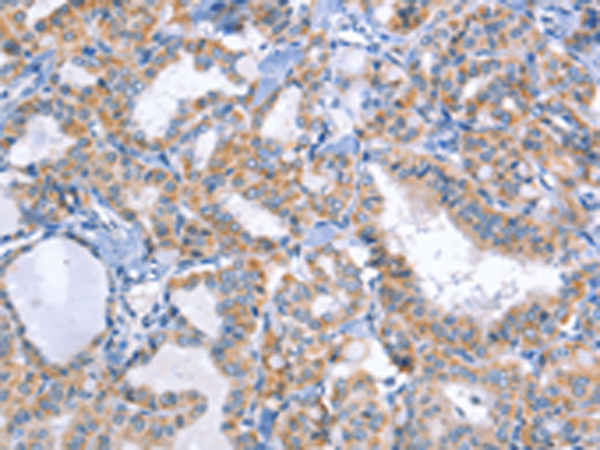


| WB | 咨询技术 | Human,Mouse,Rat |
| IF | 咨询技术 | Human,Mouse,Rat |
| IHC | 1/25-1/100 | Human,Mouse,Rat |
| ICC | 技术咨询 | Human,Mouse,Rat |
| FCM | 咨询技术 | Human,Mouse,Rat |
| Elisa | 1/1000-1/2000 | Human,Mouse,Rat |
| Aliases | MKP5; MKP-5 |
| WB Predicted band size | 53 kDa |
| Host/Isotype | Rabbit IgG |
| Antibody Type | Primary antibody |
| Storage | Store at 4°C short term. Aliquot and store at -20°C long term. Avoid freeze/thaw cycles. |
| Species Reactivity | Human, Mouse |
| Immunogen | Fusion protein of human DUSP10 |
| Formulation | Purified antibody in PBS with 0.05% sodium azide and 50% glycerol. |
+ +
以下是关于DUSP10抗体的3篇参考文献示例,按规范格式整理:
1. **文献名称**:*DUSP10/MKP-5 modulates cardiac hypertrophy through regulation of TAK1 signaling*
**作者**:Liu et al.
**摘要**:本研究利用DUSP10特异性抗体(Western blot及免疫组化)检测其在心脏肥大模型中的表达,发现DUSP10通过抑制TAK1-p38/JNK通路减轻心肌细胞肥大,提示其作为治疗靶点的潜力。
2. **文献名称**:*DUSP10 deficiency enhances colitis-associated tumorigenesis via macrophage-mediated inflammation*
**作者**:Zhang et al.
**摘要**:通过DUSP10抗体在结肠组织中的免疫荧光染色,作者揭示DUSP10敲除小鼠巨噬细胞中炎症因子分泌增加,促进结肠癌发生,证明DUSP10在调控肠道免疫微环境中的关键作用。
3. **文献名称**:*Tissue-specific expression profiling of DUSP10 in metabolic disorders*
**作者**:Wang et al.
**摘要**:研究采用DUSP10抗体进行肝脏和脂肪组织的Western blot分析,发现肥胖模型中DUSP10表达显著下调,并与胰岛素抵抗相关,提示其参与代谢调控的分子机制。
---
**提示**:实际文献需通过PubMed/Google Scholar检索确认。建议使用关键词“DUSP10 antibody”、“MKP-5 immunohistochemistry”或结合具体研究领域(如“DUSP10 cancer”)进行精准查找。
The DUSP10 antibody is a crucial tool in studying the dual-specificity phosphatase 10 (DUSP10), also known as MAP kinase phosphatase 5 (MKP5). DUSP10 belongs to the dual-specificity phosphatase family, which regulates mitogen-activated protein kinase (MAPK) signaling pathways by dephosphorylating both tyrosine and threonine residues. Specifically, DUSP10 inactivates stress-activated MAPKs, such as p38 and JNK, playing a pivotal role in modulating cellular responses to stress, inflammation, and apoptosis. It is highly expressed in immune tissues, heart, and skeletal muscle, and its activity is implicated in immune regulation, metabolic disorders, and cancer progression.
Researchers utilize DUSP10 antibodies to detect and quantify endogenous DUSP10 protein levels in various experimental models, including Western blotting, immunohistochemistry, and immunofluorescence. These antibodies help elucidate DUSP10's spatial-temporal expression patterns, post-translational modifications, and interactions with signaling partners. Studies have linked DUSP10 dysregulation to pathologies such as obesity, cardiac hypertrophy, and neurodegenerative diseases, highlighting its potential as a therapeutic target. For instance, DUSP10 knockout models demonstrate exacerbated inflammation and insulin resistance, underscoring its protective role in metabolic stress. The antibody's specificity and validation (e.g., via knockout validation or peptide blocking) are critical for ensuring reliable data in both basic and translational research contexts.
×